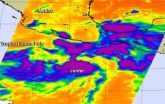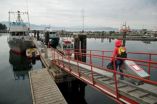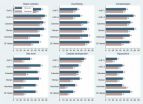(Press-News.org) Face recognition software measures various parameters in a mug shot, such as the distance between the person's eyes, the height from lip to top of their nose and various other metrics and then compares it with photos of people in the database that have been tagged with a given name. Now, research published in the International Journal of Computational Vision and Robotics looks to take that one step further in recognizing the emotion portrayed by a face.
Dev Drume Agrawal, Shiv Ram Dubey and Anand Singh Jalal of the GLA University, in Mathura, Uttar Pradesh, India, suggest that the recognition of emotions by future artificial intelligences, in the form of computers or robots, will provide a missing link between the human and machine environments without which appropriate interactions between the two domains may never be entirely successful. The team has taken a three-phase approach to a software emotion detector. The first involves developing an algorithm that can precisely identify and define the features of the human face. The second then analyses the particular positions and shapes of the face. The third phase then associates those features with a person's emotional state to decide whether they are happy, sad, angry, surprised, fearful or disgusted. Preliminary tests gave a 94 percent success rate the team reports.
While Mehrabian's 1960s notion that half of human communication is non-verbal has been debunked several times, there remains the fact that facial expressions and body language do convey a lot of information about a person's thoughts and emotional state. Such information, if it could be interpreted by a computer would allow us to enhance human-computer interactions. Imagine, whimsically, that one's laptop or smart phone could change the background image or shuffle your music based on whether you had a happy or sad expression. In a more serious setting, the recognition of anger, pent-up aggression, or fear at airport screening might allow suspicious individuals to be channeled sooner rather than later to the security office while those with nothing to hide would be funneled through to the usual physical checks with less delay.
"Our experimental results suggest that the introduced method is able to support more accurate classification of emotion classification from images of faces," the team says. They add that additional refinements to the classification algorithms will improve their emotion detector still further.
INFORMATION:
Agrawal, D.D., Dubey, S.R. and Jalal, A.S. (2014) 'Emotion recognition from facial expressions based on multi-level classification', Int. J. Computational Vision and Robotics, Vol. 4, No. 4, pp.365.
Computerized emotion detector
2014-09-16
ELSE PRESS RELEASES FROM THIS DATE:
Newborn Tropical Storm Polo gives a NASA satellite a 'cold reception'
2014-09-16
The AIRS instrument aboard NASA's Aqua satellite uses infrared light to read cloud top temperatures in tropical cyclones. When Aqua passed over newborn Tropical Storm Polo off of Mexico's southwestern coast it got a "cold reception" when infrared data saw some very cold cloud top temperatures and strong storms within that hint at intensification.
Polo formed close enough to land to trigger a Tropical Storm Watch for the southwestern coast of Mexico. The watch was issued by the government of Mexico on September 16 and extends from Zihuatanejo to Cabo Corrientes, Mexico. ...
EARTH Magazine: The Bay Area's next 'big one could strike as a series of quakes
2014-09-16
Alexandria, Va. — Most people are familiar with the Great 1906 San Francisco Earthquake and are aware of the earthquake risk posed to the Bay Area — and much of California — by the San Andreas Fault. Most people are not aware, however, that a cluster of large earthquakes struck the San Andreas and quite a few nearby faults in the 17th and 18th centuries. That cluster, according to new research, released about the same amount of energy throughout the Bay Area as the 1906 quake. Thus, it appears that the accumulated stress on the region's faults could be released in a series ...
New research decodes virus-host interactions in ocean dead zones
2014-09-16
A complex web of interaction between viruses, bacteria, and their environment is becoming ever more untangled by a growing international collaboration between Matthew Sullivan, associate professor in the University of Arizona's Department of Ecology and Evolutionary Biology and Steven Hallam from the University of British Columbia in Vancouver, Canada.
"Bacteria are drivers of nutrient and energy cycles that power the earth," Sullivan said. "As the climate is changing, so are the environments these bacteria live in, and they in turn loop back to impact their environments. ...
New research shows tornadoes occurring earlier in 'Tornado Alley'
2014-09-16
BOZEMAN, Mont. -- Peak tornado activity in the central and southern Great Plains of the United States is occurring up to two weeks earlier than it did half a century ago, according to a new Montana State University study whose findings could help states in "Tornado Alley" better prepare for these violent storms.
Tornado records from Nebraska, Kansas, Oklahoma, and northern Texas – an area of high tornado activity dubbed "Tornado Alley" -- show that peak tornado activity is starting and ending earlier than it did 60 years ago.
Peak tornado activity, which occurs ...
Long-term results of RTOG 0236 confirm good primary tumor control, positive 5-year survival rates
2014-09-16
San Francisco, September 15, 2014—Patients with inoperable, early-stage lung cancer who receive stereotactic body radiation therapy (SBRT) have a five-year survival rate of 40 percent, according to research presented today at the American Society for Radiation Oncology's (ASTRO's) 56th Annual Meeting. Such a positive survival rate is encouraging considering that historically conventional RT resulted in poor tumor control for patients with inoperable lung cancer. This study is an update of RTOG 0236, originally published in 2010 , and also conducted by the original researchers ...
Politics divide coastal residents' views of environment, UNH research finds
2014-09-16
DURHAM, N.H. – From the salmon-rich waters of Southeast Alaska to the white sand beaches of Florida's Gulf Coast to Downeast Maine's lobster, lumber and tourist towns, coastal residents around the U.S. share a common characteristic: their views about coastal environments divide along political lines. That's a primary finding of a new study by University of New Hampshire sociologists published this month in the journal Society & Natural Resources.
"We found a lot of environment-related differences from place to place to place. Each environment is different so that's just ...
Artworks are people!
2014-09-16
Not all things are created equally. We don't view a Picasso sculpture in the same way we look at a hammer, for example — no matter how fancy the hammer.
The reason? We see the Picasso more as a person than an object, according to new research from the University of Chicago Booth School of Business.
And in some cases, we make distinctions between artworks — say, an exact replica of a piece created by the artist, versus one created by a different artist.
Art, in other words, is an extension of the creator, write Professor Daniel M. Bartels of Chicago Booth, and Professor ...
For electronics beyond silicon, a new contender emerges
2014-09-16
Cambridge, Mass. – September 16, 2014 – Silicon has few serious competitors as the material of choice in the electronics industry. Yet transistors, the switchable valves that control the flow of electrons in a circuit, cannot simply keep shrinking to meet the needs of powerful, compact devices; physical limitations like energy consumption and heat dissipation are too significant.
Now, using a quantum material called a correlated oxide, Harvard researchers have achieved a reversible change in electrical resistance of eight orders of magnitude, a result the researchers ...
NASA's Global Hawk and satellites investigating Hurricane Edouard today
2014-09-16
The unmanned Global Hawk aircraft that's part of NASA's airborne Hurricane and Severe Storm Sentinel, or HS3 mission was winging its way to Hurricane Edouard on September 16. In addition to the Global Hawk, various NASA satellites are continually providing data on the Atlantic hurricane.
Scientific instruments aboard NASA's remotely piloted Global Hawk aircraft have been studying the hurricane over the last couple of days, and the Global Hawk returned to Edouard again today, September 16. Two of the instruments aboard the Global Hawk that will study Edouard are the S-HIS ...
Cancer patients with malignant spinal cord compression have preserved mobility
2014-09-16
San Francisco, September 15, 2014—Mobility is equally preserved in cancer patients suffering from malignant spinal cord compression (MSCC) who receive a single dose of 10 Gy of radiation therapy (RT), compared to patients who receive five daily doses of 4 Gy of RT each, according to research presented today at the American Society for Radiation Oncology's (ASTRO's) 56th Annual Meeting.
Malignant spinal cord compression (MSCC) is a complication of metastatic cancer mostly with bone involvement that occurs when a tumor's secondary deposit presses on the spinal cord and ...



